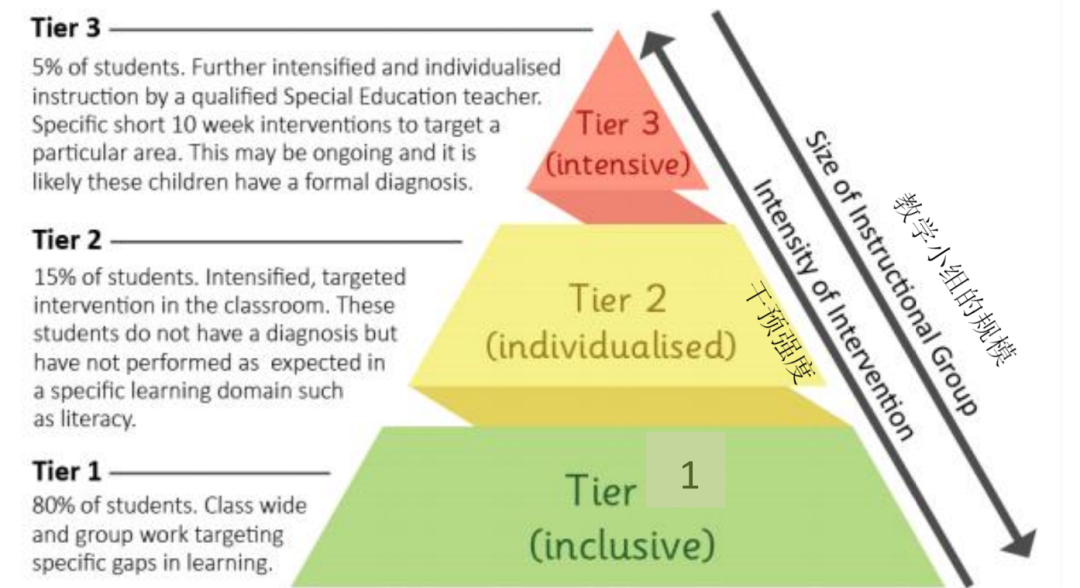揭秘青苗国际学校昆明校区小学部PYP教育干预是如何进行的?

揭秘青苗国际学校昆明校区小学部PYP教育干预是如何进行的?在青苗学校昆明校区的小学部,大多数学生都在同年级的同一阶段学习。不过每一个孩子都有自己个性特征,针对这些特征,我们就需要对孩子们进行学术上的干预。什么是学术干预呢?学术干预分为三个层次——融合教育、个性化指导和干预强化。也可以说,教育中的所有教学都是某种类型的干预,但“干预”一词通常用于第二层次和第三层次干预,也就是学生至少脱离“大部队”有一段时间了。下图清楚地阐释了在我们的教育中干预是如何进行的:
In the Primary at BIBS Kunming most students learn inclusively at grade level. There are however' outliers' students who for whatever reason need an Academic Intervention. There are three levels of intervention– inclusive, individualized and intensive. It could be said that all teaching in formal education is an intervention of some sort however the term' intervention’ is usually saved for Tier 2 and Tier 3 interventions where students are spending at least some time outside of the' mainstream' . The below graph makes it clear on how interventions work in our context:

我们如何进行学术干预?
在青苗昆明校区小学部,我们使用了RTI干预反应模型。什么是RTI呢?RTI 被广泛用于美国教育界,青苗昆明校区认为在教学中使用RIT更有利于WASC、AERO和MAP的统筹与结合。在我们的教育环境中,RTI不同于个体化教育计划,因为个体化教育计划是社会、情感和行为导向的,而RTI是以学术为导向的。由于情感和行为会影响学习的整体关系,不过两者可以互相转换。而“个人计划” 就成为二者在孩子们学习过程中的关联词汇。
The Response to Intervention Model (RTI). The RTI model is commonly used in American education circles and will hence be used here to facilitate a common vocabulary with WASC, AERO and MAP. It differens in our context from an Individualized Education Plan (IEP) in that an IEP is social, emotional and behavior directed where RTI is academically directed. The two can however become interchangeable due to the holistic and interconnected relationship of how emotions and behavior affect learning. The term Personal Plan (PP) is to become the common name among students.
我们如何进行分层教学?
当我们开始更轻松自如地使用评估数据提出问题并为未来的学习提供依据时,我们注意到了更多的“差异化”方法,以解决学校架构和课程结构安排的问题。分层教学的初衷旨在是为PYP所有的学生提供可持续、 明智的个性化学习。
As we start to feel more comfortable using assessment data to ask questions and inform future learning we should begin to see a more' differentiated' approaches to how the school is structured and then of course how your lessons are structured. The end goal of this work is to aim at making sustainable, SMART personalized learning for all students across the PYP programme.
1层级
80%-大部分学生。我们将学习差距较小的孩子分配在同一个班里进行小组学习。
2层级
15%-小部分学生。我们对这部分孩子在课堂上,进行有针对性的提高。他们有一个共同点,就是在某部分学习领域中没有达到预期的理想效果。比如英语阅读方面,我们便对孩子的这一欠缺项进行有针对的教学。
3层级
5%-较少部分学生。这部分学生的基础比较薄弱,我们便由具备专项教育资质的教师进行深化的个性指导。在指导中激发孩子的学习能动性,一对一的进行为期十周不间断教学,帮助孩子们提高。
我们如何进行个性化指导?
青苗昆明校区使用“SMART”学习目标来构建“个人计划”。这一计划必须满足以下要求:
S (具体的) :
清晰描述出需要实现的目标。
M (可量化的) :
包含一个可以看得到成果的指标。
A (可实现的) :
设定一个与现实相关且具有挑战性的目标。
R (相关联的) :
让目标与更高层次的目标保持一致。
T (有时限的) :
为目标实现设定一个期限。
BIBS Kunming uses "SMART" learning goals to construct "personal plans". The plan must meet the following requirements:
S (specific) :
Clearly describe what needs to be achieved.
M (measurable) :
Include a metric where you can see results.
A (achievable) :
Set a realistic and challenging goal.
R (relevant) :
Align goals with higher level goals.
T (time-bound) :
Set a deadline for achieving your goal.
个性化学习如何能够成为可持续性的进行?理论上的完美却有一些现实的局限性,比如每个班最多由每组五名学生共四组进行轮流读写,这是可以完成的,但每组一名学生共二十组是几乎不可能实现的。个性化学习必须是轻量化的,才能有效甚至高效。从预评估、课堂互动、年级要求和家长会中我们发现,尽管每个学生都有自己需要改进的某一方面,但某一学生的需求和其他学生的需求是有许多重合部分的。
How is Personalized Learning Sustainable ? Differentiation, for all its theoretical perfection does has its realistic limits, although it is economical to have up to four groups of five students for literacy rotations per class – twenty groups of one student would be practically impossible. Personalized learning must be light-weight if it is going to be efficient and effective. From pre-assessment, in-class interactions, grade level expectations and parent meetings you will find that although each student has their own specific areas needing improvement there is too a lot of overlap between the needs of one student and the needs of others.
我们如何引导“个人计划”?
个人计划是每学年一次计划,由学生制定、家庭商议、教师决定,最后做成A3或A4海报展示在班级的墙上,之后放在个人作品集的第一页。学生的个人计划将会成为作品集的关键指导,作品集会按照计划进行收集。计划中列出的目标将决定哪些内容“有价值”,哪些内容不必要。换句话说,个人作品集有效的体现了孩子们的学习成果。这也是一种目标更明确,沟通更具体的学习方式。
Personal Plans are semester-long or year-long plans that are decided by teachers – agreed upon by families and made by students - presented in A3 or A4 poster format to go on the walls of classes and then on the first page of portfolios. A student’s personal plan will be the key guiding function for how the portfolio follows. The goals outlined in the plan will determine what content is' portfolio worthy' and what is not. Put another way, the portfolio provides evidence of the personal plan having been met. It is learning with increased purpose and more explicit communication.
孩子们的个人计划必须有最多 (不超过) 三个的SMART目标,孩子们的目标可能是相同的,但对于每一个个体来说却是详细具体的。这些计划的目的有两个——让学习变得直观可见;让学生自己、家长和教师对学习负起责来。我们今年的“主要重点”依然是阅读,更具体来说是提高全校的阅读水平,所有学生都必须在阅读方面设定SMART目标。另外两个目标,一个是学术目标,另一个则是社交—情感—行为目标。在本学年,我们依旧期待着每一位孩子都能够为我们带来成长的惊喜!
The child's individual plan must have up to three SMART goals. The children's goals may be the same, but they are specific to each individual. The purpose of these programs is twofold -- to make learning intuitive; Let students themselves, parents and teachers take responsibility for learning. Our "main focus" this year continues to be on reading, and more specifically on improving reading standards throughout the school, where all students must set SMART goals in reading. The other two goals, one is an academic goal and the other is a social-emotional-behavioral goal. In this school year, we are still looking forward to every child can bring us growth surprises!
- 上一篇:2022 _ 2023学年广州暨大港澳子弟学校春季插班生招生计划!
- 下一篇:没有了
免责声明
(一) 由于各方面情况的调整与变化,本网所提供的【揭秘青苗国际学校昆明校区小学部PYP教育干预是如何进行的? 】仅供参考,并不意味赞同其观点或证实其内容的真实性,相关信息敬请以权威部门公布的信息为准。
(二) 本网未注明来源或注明来源为其他媒体的稿件均为转载稿,免费转载出于非商业性学习目的,版权归原作者所有,如有内容、版权等问题,请在30日内通过邮件的方式与本网联系。邮箱:myzp@foxmail.com 我们将会在收到邮件后尽快进行处理。
(三) 〖揭秘青苗国际学校昆明校区小学部PYP教育干预是如何进行的? 〗链接地址:https://guojixiao.com/z/33325.html , 转载时请注明来源及保留本站链接。
